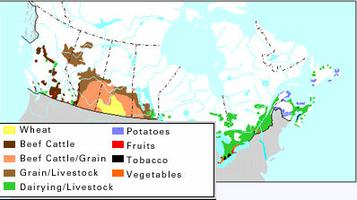
Tobacco (Nicotiana tabacum) is an annual (potentially perennial) herbaceous plant of the nightshade family. It evolved in Central America from a natural crossing between N. sylvestris and N. tomentosiformis. The plant has a fibrous root system and a cylindrical stem which terminates in a cluster of over 150 funnel-shaped, pink flowers with 5 petals. The fruit is a capsule with 2 or 4 compartments; each capsule may produce 4000-8000 seeds. The commercially important part of the plant, the leaves, are arranged in a spiral on the stalk and are oval with a pointed apex. Leaves average 23-30 cm wide and 55-60 cm long. Canada ranks among the top 12 tobacco-producing countries and produces 5 major types: flue cured, ie, heat cured; and burley, cigar, dark and pipe, which are air cured. Tobacco is primarily smoked as cigarettes or cigars; chewing and snuff products constitute a small proportion of the consumer market.
Tobacco was cultivated by the Petun, Neutral and Huron of southwestern Ontario and was an important item of trade. Commercial tobacco cultivation in Canada began in the early 1800s and, until 1920, was mainly restricted to the burley type. Flue-cured tobacco was introduced to Ontario around 1900 and it is now the major tobacco type (95-98%) grown in Canada; 90% is produced in southwestern Ontario. Flue-cured tobacco was introduced to Québec, Nova Scotia, PEI and New Brunswick in 1930, 1958, 1959 and 1963, respectively. Tobacco seeds are sown in sterile muck in greenhouses during the first week of April, and seedlings are transplanted into the field in late May and early June. Plants require approximately 220-250 mm of rainfall, 115-120 frost-free days, and mean monthly temperatures of 19-23°C. Pests and other problems include cutworms, hornworms, aphids, damping-off, black root rot, blue mold, nematodes and weeds. Plants are topped at a height of 16-19 marketable leaves, generally in late July. Leaves start maturing from the bottom and are harvested in batches of 2-3 leaves per harvesting or priming, a week apart. Harvested leaves are cured in a curing barn or kiln. High-temperature drying arrests the natural chemical processes and turns the leaves a golden colour. Air-cured tobaccos are usually stalk cut, hung on sticks and allowed to dry naturally in a barn. The final product is brown.
See also Smoking.

 Share on Facebook
Share on Facebook Share on X
Share on X Share by Email
Share by Email Share on Google Classroom
Share on Google Classroom


